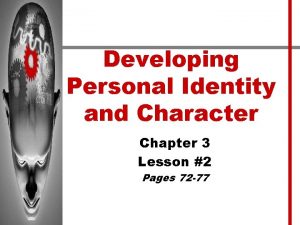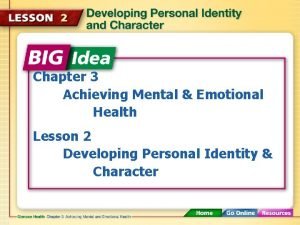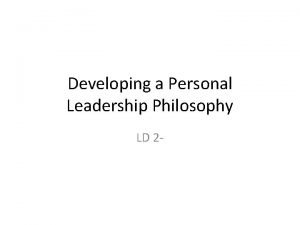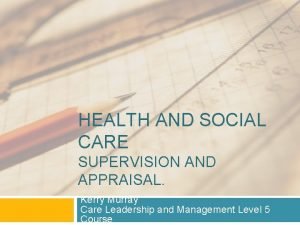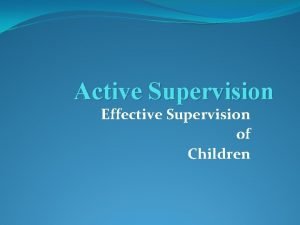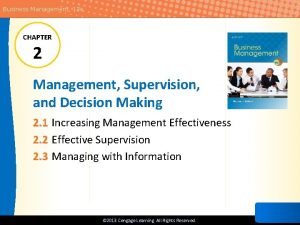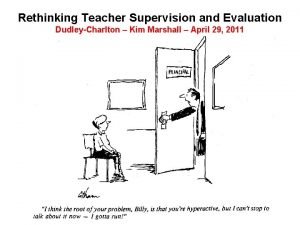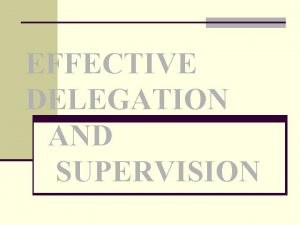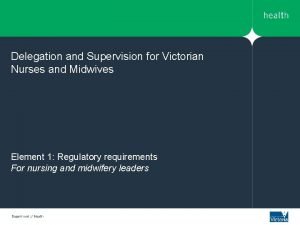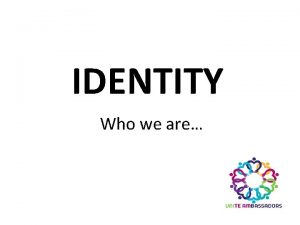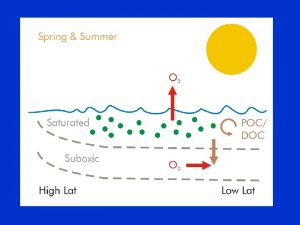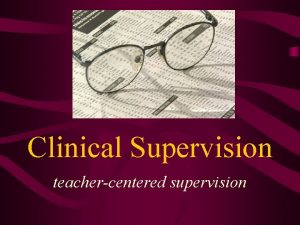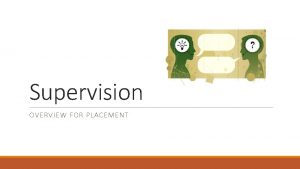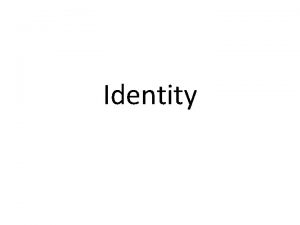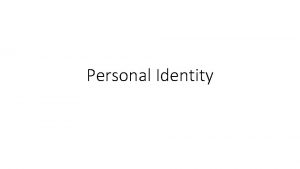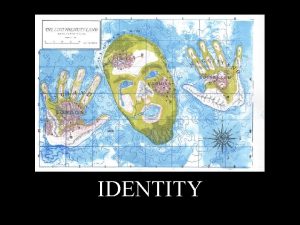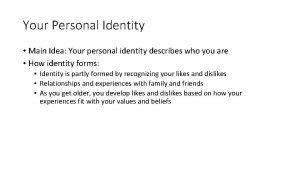Professional supervision supporting and developing your professional identity























- Slides: 23

Professional supervision – supporting and developing your professional identity Dr Wendy H Mc. Intosh Ph. D RGN, Grad. Dip. MH, MN

1 CNE Points Continuing Nurse Education Points as part of Royal College of Nursing, Australia Lifelong Learning Program (3 LP) This session has been Endorsed by APEC No. 060210229 as Authorised by Royal College of Nursing, Australia according to approved criteria Royal College of Nursing Australia recommends that nurses should aim to achieve 20 CPD points per year.


Objectives • Discuss purpose of professional supervision • Demonstrate understanding of the term supervision • Demonstrate understanding different modes of professional supervision • Discuss the history of professional supervision in health • Describe process of professional supervision • Reflect on stories from the field and. .

Invite reflection of how professional supervision may assist you in your practice (clinical, research, education)

Definitions Supervision. . the act of watching over the work or tasks of another who may lack full knowledge of the concept at hand. Supervision does not mean control of another but guidance in work, professional or personal context (accessed 9/10/2011 supervision. askdefine. com)

Purpose of professional supervision • develop clinical wisdom • deepen understanding of functioning of patient • allows dialogue between practicing professionals to enable further development of professional skills (Butterworth, 1994) • facilitate the development of an increasing capacity to tolerate feelings born of “not knowing what to do” until something more clinically relevant begins to emerge (Bion, 1967)

• to create and provide an environment that permits and provokes the emergence of the supervisee’s spontaneity and creativity that will support them past their impasse (frustration, despondency, anger) so that they can re-enter the client’s system to do what they have to do with confidence (Fergus, 1989: 2 -20)

• interpersonal process where the supervisee can become more conscious of their own characteristic patterns of relating and through this process can also begin to see more clearly the characteristic dysfunctional patterns of how their clients relate and make interventions which address these in an integrated way (Eckstien & Wallerstein, 1958)

Four modes administrative – mainly supervisor directed – supervisor decides what the supervisee should learn in order to be a safe practitioner consultative - supervisee decides what needs to be learnt and consults with a colleague who takes up certain roles so that difficult matters might be thoroughly examined

educational – supervisor assists the supervisee to formulate an adequate conceptualization of the clients difficulty therapeutic – focus is on the internal world of the supervisee – in this mode the supervisor is primarily a therapist focusing on the supervisory relationship itself (Fay 1993)

Clinical Supervision (CS) Brunero & Stein-Parbury (2008). proposed that in CS the clinician reflects back on clinical experiences in order to recount them and deepen understanding and / or identify areas for further improvement

Restorative Normative Formative (Proctor, 1987)

Effectiveness of CS Restorative - ventilates thoughts & feelings, reduce levels of anxiety and conflicts, develop better interpersonal relationships and improve coping ability Normative – developing strategies to manage professional accountability & quality issues, developing a stronger sense of professional identity & job satisfaction has been associated with decreased stress & decreased burnout Formative - ^ knowledge, ^ self awareness, ^ creativity and innovation

Reflective not reactive Objective Understanding the Unspoken dynamic

Stories

Benefits - Individual White et al, (1998) found that CS provided a“ structured opportunity to talk meaningfully to a trusted colleague about their circumstances at work” p 629 Increased clinical insight, Increased personal confidence and stronger working relationships Professional development Support Reflection Improvements to standards of care (White & Roche, 2006)

Benefits - Organisation

Acknowledgment Like to thank the work of Mike Consedine (1998) for his work and writing on professional supervision for psychiatric nurses in New Zealand Australia. Your writing and commitment to supervision has been an inspiration to me

References Bion, W. (1967). A theory of thinking. In Second thoughts, selected papers on psychoanalysis. Heineman: London. Brunero, S. , Stein-Parbury, J. (2008). The effectiveness of clinical supervision in nursing: an evidenced based literature review. Australian Journal of Advanced Nursing, 23 (3), 86 -94. Butterworth, T. (1952). Clinical supervision as an emerging idea in nursing. In Butterworth, T. , & Faugier, J. Clinical supervision and mentoring in nursing. Chapman & Hall: London. Consedine, M. (1998). Utilization of role theory in clinical supervision (1998) Thesis to the Board of Examiners of the Australian & New Zealand Psychodrama Association Incorporated Ekstein, R. , & Wallerstein, R. (1958). The teaching and learning of psychotherapy. 2 nd edition (1972). International Press: New York.

Fay, J. (1993). Lifetime psychotherapy sessions: The territory and the map. Presentation at plenary session of the New Zealand Association of Psychotherapists Annual Conference. Proctor White, E. , Butterworth, T. , Carson, J. , Jeacock, J. , & Clements, A. (1998). Clinical supervision: insider reports of a private world. Journal of Advanced Nursing, 28 (1), 185 -192. White, E. , & Roche, M. (2006). A selective review of mental health nursing in New South Wales, Australia, with particular reference to clinical supervision. International Journal of Mental Health Nursing, 15, 209 -219.

Next 2 day workshop on professional boundaries: Date: Nov 3 rd & 4 th Venue: Davaar Consultancy 184 Patrick Street, Laidley, Qld. 4341 Download flyer from website: www. davaar. com. au

Resources Want to access our new internet training tool on professional boundaries ? go to http: //training. davaar. com. au/ Contact us: wendy@davaar. com. au Web: www. davaar. com. au Mobile: 0411 385 573
 Good qualities of a person
Good qualities of a person Developing personal identity and character
Developing personal identity and character Chapter 3 achieving mental and emotional health
Chapter 3 achieving mental and emotional health Your conscious awareness of your own name and self identity
Your conscious awareness of your own name and self identity Identity project ideas
Identity project ideas Download developing your leadership philosophy
Download developing your leadership philosophy Chapter 3 mental and emotional health
Chapter 3 mental and emotional health Developing your leadership philosophy classes
Developing your leadership philosophy classes Appraisal health and social care
Appraisal health and social care Give us your hungry your tired your poor
Give us your hungry your tired your poor Objective of supervision
Objective of supervision Objective of supervision
Objective of supervision Perbedaan pengawasan dan pengendalian dalam manajemen
Perbedaan pengawasan dan pengendalian dalam manajemen Chapter 2 management supervision and decision making
Chapter 2 management supervision and decision making Rethinking teacher supervision and evaluation
Rethinking teacher supervision and evaluation Difference between project monitoring and evaluation
Difference between project monitoring and evaluation Delegation and supervision
Delegation and supervision 5 rights of delegation nursing australia
5 rights of delegation nursing australia What makes up your identity
What makes up your identity What makes up your identity
What makes up your identity What shapes your identity
What shapes your identity Managing your online identity
Managing your online identity Embracing your identity
Embracing your identity Confirm your identity facebook hack
Confirm your identity facebook hack

